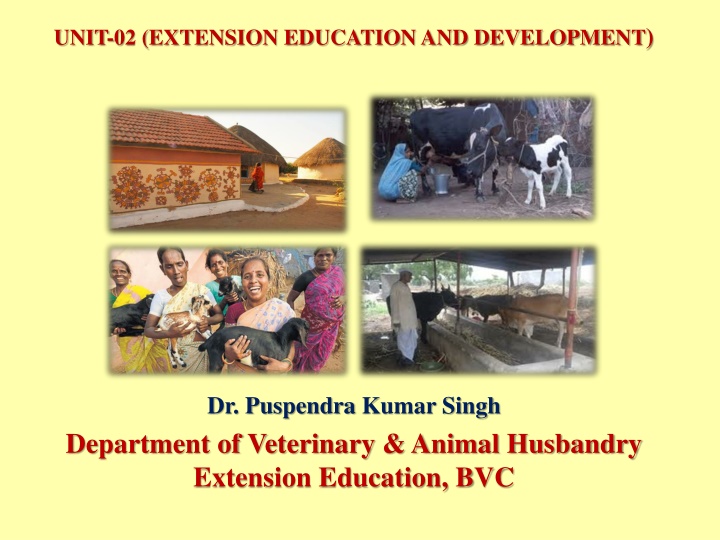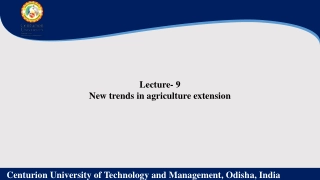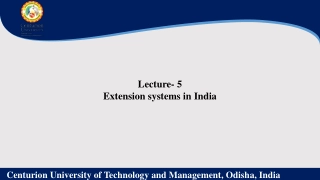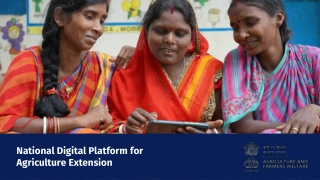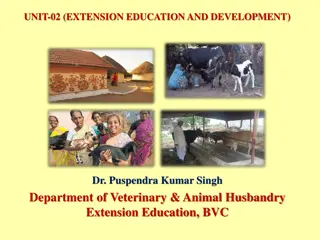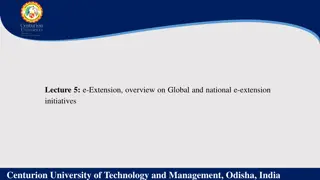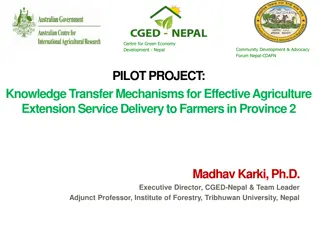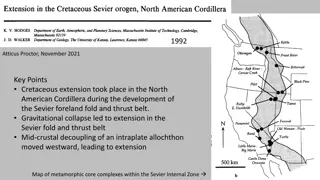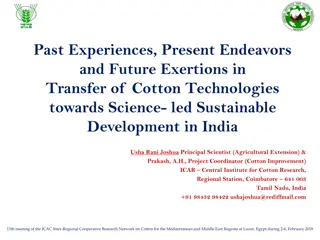History of Extension Education and Development in India
This detailed content outlines the history and evolution of extension education and development in India, from early initiatives by outstanding individuals to the establishment of agricultural research institutions and the implementation of various schemes for rural reconstruction. It covers key stages such as Pre-Independence Era, Post-Independence Era, and Intensive Agricultural Development Era, highlighting milestones, notable efforts, and key developments in the field.
Download Presentation

Please find below an Image/Link to download the presentation.
The content on the website is provided AS IS for your information and personal use only. It may not be sold, licensed, or shared on other websites without obtaining consent from the author.If you encounter any issues during the download, it is possible that the publisher has removed the file from their server.
You are allowed to download the files provided on this website for personal or commercial use, subject to the condition that they are used lawfully. All files are the property of their respective owners.
The content on the website is provided AS IS for your information and personal use only. It may not be sold, licensed, or shared on other websites without obtaining consent from the author.
E N D
Presentation Transcript
UNIT-02 (EXTENSION EDUCATION AND DEVELOPMENT) Dr. Puspendra Kumar Singh Department of Veterinary & Animal Husbandry Extension Education, BVC
Extension Education and Development 3rdYear, VAHEE
Topics covered Pre development programmes Independent rural
Genesis of extension The term Extension Education first used by Cambridge University in 1873 Later on Land Grant College in USA formally established theAgricultural Extension work ICAR established in 1929 as Imperial Council of Agricultural Research after recommendation of Royal Commission of Agriculture, 1928. FirstAgricultural University in India at Pantnagar (1960)
Early Extension Activities in India Few outstanding individuals made scattered and short lived efforts CD & NES - recent origin Stage I Pre-Independence Era (1866-1947) Stage II Post-Independence Era (1947-1952) Stage III-CD & NES Era (1952-1960) Stage IV-Intensive Agri. Dev. Era (1960 onwards)
Stage I: Pre-Independence Era (1866-1947) 1866 Appointment of famine commission Imperial Dept.Agri. (GOI) June 1871 Famine commi. (1980)- estd. of imperial dept. in most states skeletal form (1882) Famine commi. (1901)- estd. Imperial Agri. Research Institute at Pusa (Bihar) Agri. College & IndianAgricultural Services Institute ofAgri. Research at Pusa (1905) Royal commission Imperial Council of Agricultural Research (Now ICAR, New Delhi) - 1929
Some efforts by outstanding individuals / organizations Scheme of rural reconstruction - Daniel Hamilton (1903) Servants of Indian Society G.K.Gokhale (1905) Rural reconstruction work by Christian mission (1914) Economic Conference of Mysore Dr. M.Vishweswarya (1914- 18) Gurgaon Experiment F.L.Brayne (1920) Shri Niketan project R. Tagore (1921) Marthandam attempt Dr.S. Hatch (1921) Sevagram attempt Mahatma Gandhi (1923) Indian Village Service A. T. Mosher & B.N.Gupta - 1945 Firka development scheme of Madras state T. Prakasam (1946)
Scheme of Rural reconstruction (1903) Daniel Hamilton Experiment in model villages with co-operative line Sundarban (Bengal) Objectives: - Co-operative marketing Training to the villagers in cottage industries Limitations: - Without financial support Area of operation was small Limited activities Less involvement of peoples Staff were untrained
Servants of Indian Society (1905) Gopal Krishna Gokhale Pune Objectives: - Socio-economic & educational activities Training centres, published booklets Limitations: - Lack of finance Lack of involvement of peoples Untrained staff
Rural reconstruction work by Christian Mission (1914) Christian college, Lahore & Nagpur Allahabad Agricultural Institute Mission Hospitals spread throughout the country Agricultural demonstration centres at Marthandam, Ramnathpurum, Patanchery Institutions like YMCA & YWCA in rural areas Objectives: - To spread literacy To provide medical service Rural reconstruction
Gurgaon Experiment (1920) Pioneer effort by F.L.Brayne at Gurgaon (Punjab) Objectives: - To jerk the villager out of his old groove To convince improvement To kill his fatalism To teach better ways of living and farming Approach:- Paid Village Guide , Initially create desire for improvement & then launch innovations Limitations: - Village guide were not technical man, inexperienced, and untrained Entirely dependent on a single person Little improvement was achieved Attempts were limited to few villages
Shri Niketan Project (1920) Poet Rabindranath Tagore with the help of L.K.Elmhirst Kaligram Pargana Objectives: - To create interest for rural welfare To study rural problems & its solution in action To help villagers to develop resources To improve village sanitation Limitations: - Approach:- Not get much help from govt. Creating a spirit of self help Developing village leadership Area of operation was small Organizing village scouts (Brati Balika) Came to an end with his death Establishing training centres for handicrafts and Demonstration centre at Shantiniketan
Marthandam Attempt (1921) Dr. Spencer Hatch Marthandam (near Kanyakumari) in Tamil Nadu Objectives: - Mental, Spiritual, Physical, Economical and Social Development Approach:- Run through YMCA Demonstrations centre (chief power house) Key note of centre Self help with intimate expert counsel Limitations: - Lack of funds and govt. backing No continuous contact with the villagers Sponsored by religious institution
Sevagram Attempt (1923) Mahatma Gandhi at Sevagram, Wardha District Objectives: - To provide service to underprivileged To achieve self dependency To provide basic education (Nai Talim) To organize training to develop cottage industry Removal of untouchability, stressing women education, and preaching communal unity Limitations: - No well defined methods Gandhiji set a very high personal standards
Firka development scheme of Madras state (1946-47) Shri. T. Prakasam Govt. sponsored Inspired from Gram Swaraj of Gandhiji Objectives: - All round development of individual To develop means of drinking water, irrigation & communication To develop co-operatives, village associations To improve animal husbandry, farming To introduce Khadi & cottage industry Limitations: - Restricted scope Lack of co-ordination Lack of financial support
